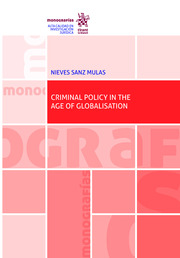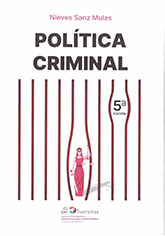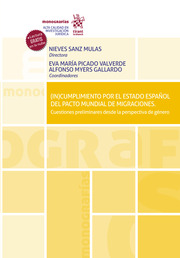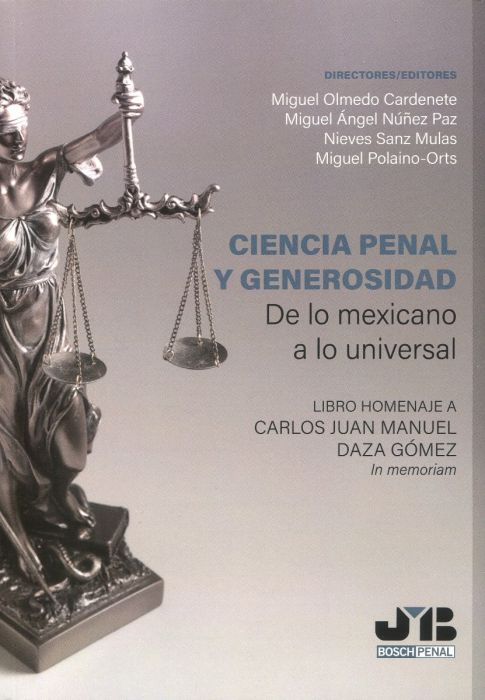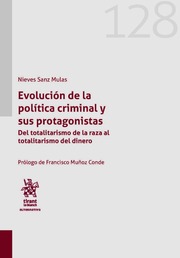Criminal policy in the age of globalisation
- ISBN: 9788413783246
- Editorial: Editorial Tirant lo Blanch
- Fecha de la edición: 2021
- Lugar de la edición: Valencia. España
- Colección: Monografías
- Encuadernación: Rústica
- Medidas: 22 cm
- Nº Pág.: 100
- Idiomas: Inglés

Criminal Policy is the Law Subject devoted to seeking real and feasible solutions to problems, as serious as those discussed in this book. Issues such as the obvious authoritarian trait of criminal law, a reflection of its progressive dependence on political and media power. And, of course, also of some economic interests that evolve towards a neoliberal model in which figures matter much more than people. Or past problems not yet resolved, such as abortion, gender violence or drug trafficking. Additionally, new challenges such as organized crime and its close relationship with phenomena, such as corruption and white-collar crime, sky-rocketing in a global and interconnected world. Not to mention terrorism, especially the jihadist, a reflection, to a large extent, of the resounding failure in the integration of immigrants. Human migration, in turn, unstoppable, despite the increasing stubbornness of States to close their borders, thereby condemning thousands of people to death. The alternative to rotting in a refugee camp is sometimes only one: turning to organized crime seeking vital opportunities that the States either due to destination or origin, withhold. Because going from victim to criminal had never been so simple as it is now, and also with the back-up from the international community.
INTRODUCTION 15
Chapter 1
A CONCEPTUAL APPROACH TO CRIMINAL POLICY
I. CRIMINAL POLICY AS PART OF STATE POLICY 19
1. Totalitarian states and criminal policy 19
2. Criminal policy in democratic states: crime prevention under a social and democratic rule of law 19
II. CRIMINAL POLICY AS A DISCIPLINE 20
III. POSSIBLE CRIMINAL POLICY PROPOSALS 21
1. Social policies: with special reference to education policy 21
2. Media policies 22
3. Other legal proposals: administrative sanctioning law 22
4. Restorative justice 23
5. Penal proposals 23
Chapter 2
CRIMINAL POLICY IN THE AGE OF GLOBALISATION
I. FEATURES OF TODAY’S SOCIETY 25
1. The international protection of human rights and its limitations 25
2 The crisis of the welfare state and neoliberalism 26
3. Globalization and the risk society 27
II. CRIMINAL POLICY IN THE AGE OF GLOBALISATION 28
1. Symbolic criminal law 28
2. Criminal risk law 29
A) The Zero-Tolerance Strategy 29
B) The bureaucratization of criminal law 29
3. Enemy criminal law 30
III. THE NEW CRIMINAL POLITICAL AUTHORITARIANISM IN SPAIN 31
1. The phantom enemy in Spanish criminal law 31
2. Real crime and perceived crime: the cost of punitive populism 31
Chapter 3
THE DRIVERS OF CRIMINAL POLICY
I. THE INTERNATIONALISATION OF CRIMINAL LAW 33
II. THE MEDIA AND PUNITIVISM 34
1. Media, public opinion and criminal policy 34
2. Agenda-setting and the relevance of criminality 35
3. The framing technique and its influence on criminal policy 35
III. POWERS BEHIND THE MEDIA AGENDA 36
1. Political parties and the media 36
2. Victims’ associations and other special interest groups (lobbies) 37
3. Media control and deontological ethics 37
Chapter 4
CRIMINAL POLICY IN THE PROTECTION OF LIFE
I. THE PROTECTION OF LIFE AS A BASIC LEGAL RIGHT 39
II. HOMICIDE VS. MURDER 39
III. THE DEBATE ON SUICIDE AND EUTHANASIA 40
IV. PREGNANT WOMEN’S CONSENT AND THE CRIME OF ABORTION 42
Chapter 5
CRIMINAL POLICY ON GENDER VIOLENCE
I. THE SERIOUS PROBLEM OF GENDER VIOLENCE 45
II. LIGHT AND SHADE IN THE FIGHT AGAINST GENDER VIOLENCE 45
1. The Comprehensive Law against Gender Violence and the State Pact 45
2. The choice of a gendered criminal law without a gender perspective 46
3. An almost exclusive focus on mild acts of male violence 47
4. The victimization and protection of women against their will 47
5. Protection orders and false reports 48
III. TOWARDS A TRULY COMPREHENSIVE SOLUTION 49
Chapter 6
CRIMINAL PROTECTION OF SEXUAL FREEDOM
I. SEXUALITY AND THE STATE MODEL 51
II. FROM THE PROGRESSIVE REFORMISM OF THE 1995 PENAL CODE TO THE MORALISATION OF SEXUALITY 52
III. CHILD SEXUALITY AND CRIMINAL POLICY 53
IV. CRIMINAL POLICY ON PROSTITUTION 55
1. Between abolitionism and soft prohibitionism 55
2. Towards a regulatory model for prostitution 55
Chapter 7
THE CHALLENGE OF TRANSNATIONAL ORGANISED CRIME
I. THE PHENOMENON OF ORGANISED CRIME 57
II. TRANSNATIONAL ORGANISED CRIME AND CRIMINAL HARMONISATION 58
III. SPANISH CRIMINAL LAW AGAINST ORGANISED CRIME 59
1. The limits of traditional criminal law 59
2. Inadequate response to crimes of membership of a criminal organization or group 60
IV. CRIMINAL POLICY ALTERNATIVES 61
Chapter 8
CRIMINAL POLICY ON ILLEGAL IMMIGRATION AND HUMAN TRAFFICKING
I. THE MIGRATION PHENOMENON IN THE ERA OF GLOBALISATION 65
1. Migratory movements and border closures 65
2. The over-criminalization of immigrants as dangerous people 66
II. CRIMINAL POLICY ON ILLEGAL IMMIGRATION 67
1. The crime of migrant smuggling 67
2. Alternative criminal policy 68
III. HUMAN TRAFFICKING 69
1. Criminal policy on human trafficking 69
2. Towards a comprehensive criminal policy 70
Chapter 9
CRIMINAL POLICY ON DRUGS
I. THE INEFFECTIVENESS OF THE CURRENT WAR ON DRUGS 73
II. PENALISATION VS LEGALISATION 73
1. The progressive abandonment of zero tolerance 73
2. Individual freedom vs. public health: (soft) drugs vs. alcohol and tobacco 75
III. ALTERNATIVE CRIMINAL POLICY: THE PORTUGUESE EXAMPLE 76
Chapter 10
CRIMINALITY AND POWER: CRIMINAL POLICY ON CORRUPTION AND WHITE-COLLAR CRIME
I. GLOBALISATION AND PUBLIC CORRUPTION 79
II. POLITICIANS AND BUSINESSMEN: DANGEROUS FRIENDSHIPS AND IMPUNITY 80
III. MEASURES AGAINST WHITE-COLLAR CRIME: THE CRIMINAL LIABILITY OF LEGAL PERSONS 81
IV. MEASURES AGAINST PUBLIC CORRUPTION 82
1. Reform of crimes against public administration and the crime of illegal party financing 82
2. The necessary specialization, means and independence of judges and prosecutors 83
3. International collaboration in recovering money and ending tax amnesties 83
4. Administrative control of public management and essential social awareness 84
Chapter 11
CRIMINAL POLICY AGAINST TERRORISM
I. THE CHALLENGE OF ISLAMIC TERRORISM: THE JIHAD GENERATION 85
II. INTERNATIONAL CRIMINAL POLICY ON TERRORISM 86
1. The concept of terrorism and its components 86
2. Preventive wars and enemy criminal law as an international strategy against terrorism 87
III. ANTI-TERRORIST CRIMINAL POLICY IN SPAIN AND ENEMY CRIMINAL LAW 87
IV. CRIMINAL POLITICAL ALTERNATIVES TO THE TERRORIST PHENOMENON 89
1. The illegitimacy of the war on terrorism and the ineffectiveness of criminal law as the sole solution 89
2. Parallel societies and homegrown terrorism 89
3. For a criminal law that provides safeguards against terrorism 90
Chapter 12
CULTURAL DIVERSITY AND CRIMINAL POLICY
I. MIGRATION AND CULTURAL DIVERSITY: MANAGEMENT MODELS 93
1. The French assimilationist model 94
2. The English multiculturalist model 94
3. The contradictory Spanish position on multiculturalism 95
II. MULTICULTURALISM AND CRIMINAL LAW 95
1. Hate crimes 96
2. Culturally motivated crimes (cultural crimes) 96
A) Concept and requirements 96
B) Management models 97

